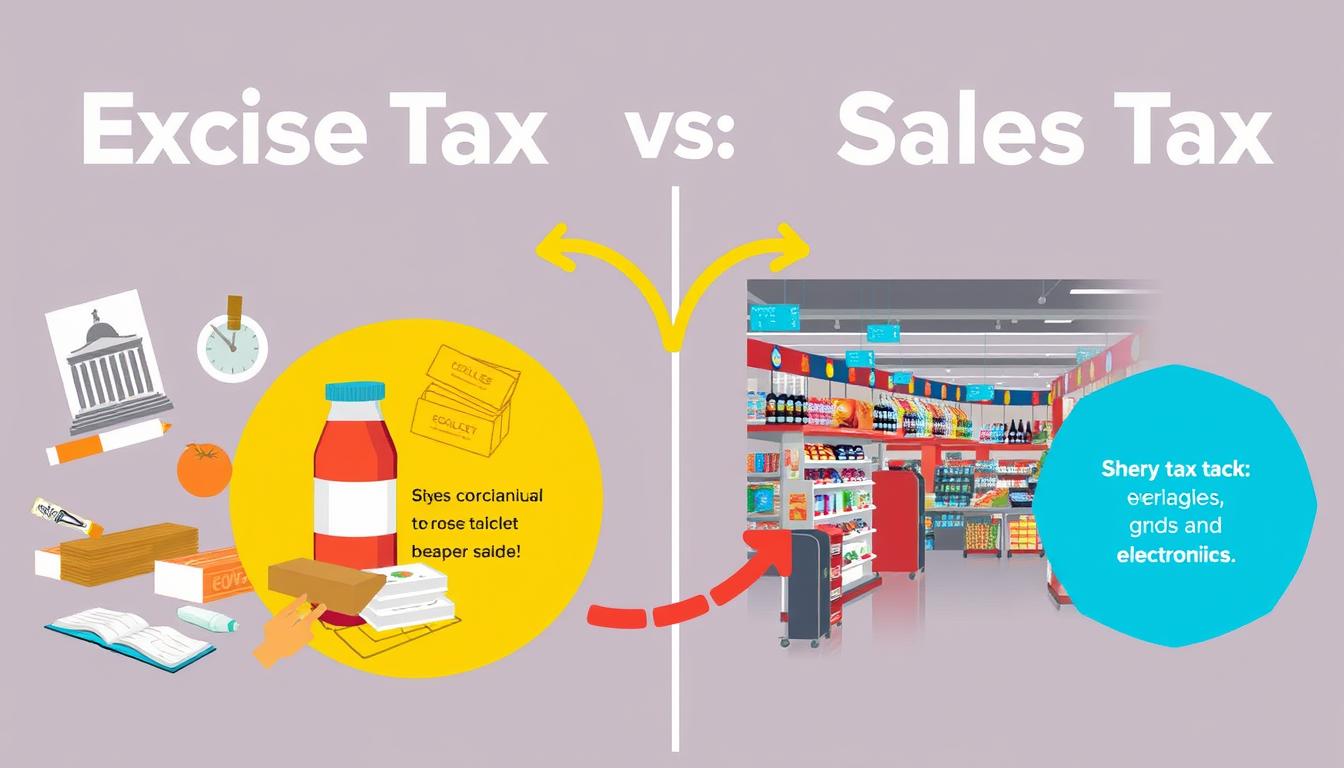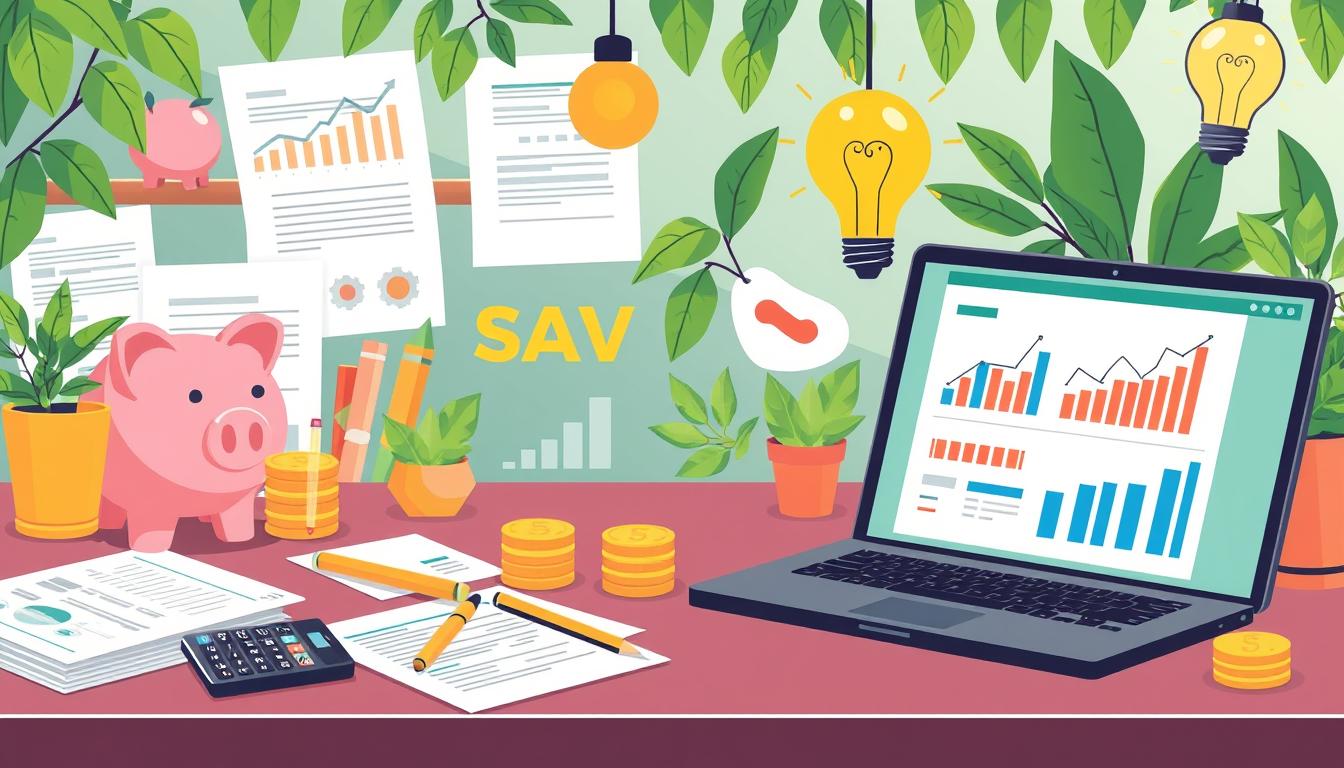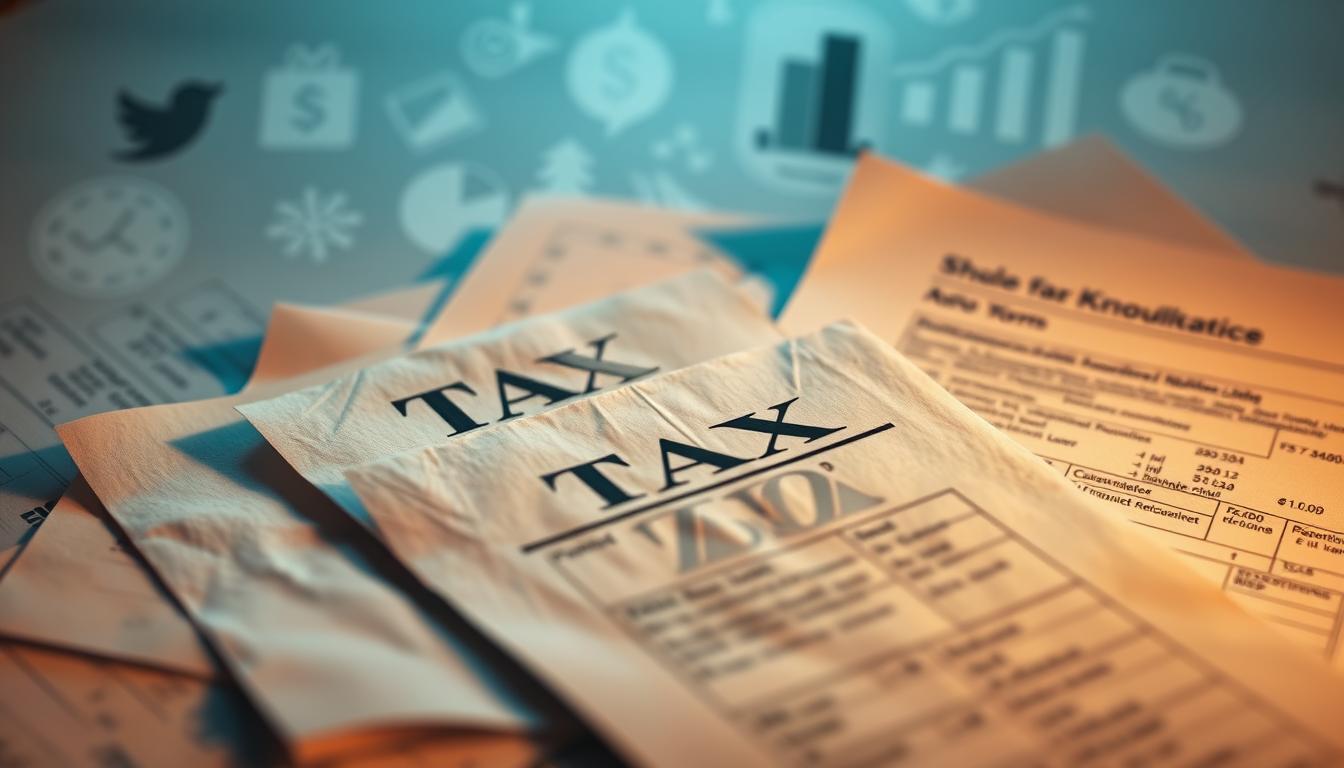Did you know that gasoline has a federal excise tax of 18.3 cents per gallon1? Meanwhile, diesel gets taxed at 24.3 cents per gallon. This shows how complex consumer taxes can be in the U.S. It’s vital to know the differences between excise tax and sales tax. These taxes can greatly affect what we buy and the economy. In this piece, we will dive into what these taxes are, how they’re applied, and what they mean for you. This will help you understand the U.S. tax system better.
Key Takeaways
- Excise taxes are specific levies on certain goods and services, like fuel and luxury items.
- Sales taxes are broader, applied to a vast array of retail transactions.
- Understanding the differences can help you make informed financial decisions.
- States impose varying rates for both excise and sales taxes, affecting overall costs.
- Awareness of these taxes can influence your purchasing behavior.
What is Excise Tax?
Excise tax is a tax on specific goods and services. Its main purpose of excise tax is to bring in money for government programs. This is especially for products that can harm health or the environment, like alcohol, tobacco, and fuel. Unlike broader sales taxes, excise taxes are usually included in the item’s price, so buyers might not notice them.
Definition and Purpose
The excise tax definition focuses on taxes for certain items to cut down on unhealthy habits and fund vital public works and services. In the US, excise taxes make up about 4% of federal income. This is much less than the 12% average in OECD countries2.
Types of Excise Taxes
There are two main types of excise taxes: specific and ad valorem. Specific excise taxes charge a set amount per unit, like a $0.184 per gallon gas tax, making up almost half of all excise tax revenue2. On the other hand, ad valorem taxes are based on the sale price’s percentage and affect many products, including luxury items and alcohol.
Common Products Subject to Excise Tax
Many products are affected by the common products excise tax. This list includes tobacco, alcohol, fuel, and luxury cars. For example, excise taxes on cigarettes differ by state, with Virginia at $0.30 and New York at $4.35 per pack2. Excise taxes also hit airline tickets, indoor tanning services with a 10% tax, and archery gear3.
What is Sales Tax?
Sales tax plays a key role in the US economy. It helps both buyers and sellers understand the financial system. This tax is charged by state and local governments when you buy goods and services.
Definition and Purpose
The term sales tax means a tax on what you buy. It is a percentage of the selling price. The goal of sales tax is to fund public services. These include schools and road work. Sales tax applies to many products, providing important funds for governments.
How Sales Tax Works in the U.S.
Sales tax rates in the U.S. can be between 0% and 9.5%. This depends on where you are. A 2018 legal decision made online businesses pay sales tax too. This was to ensure fair competition with traditional stores.
Let’s say you buy a $10 book in Michigan. A 6% sales tax adds 60 cents to your bill, making it $10.60. Every state has different rules on what gets taxed, making things complex.
Common Exemptions in Sales Tax
There are some things sales tax doesn’t apply to. These exemptions help lower costs for consumers. Items like groceries and medicine often don’t have sales tax. Also, certain items for business use or specific groups, like veterans, may be exempt. Understanding exemptions can help you save money based on the state law.

How is an Excise Tax Different from a Sales Tax?
Knowing how excise tax differs from sales tax is key for everyone. These taxes work in different ways, with their own rules and methods of being added.
Scope of Application
The scope of taxes clearly shows how excise and sales taxes are not the same. Excise taxes target specific items like tobacco, alcohol, and gasoline. This is different from sales tax, which affects a wide range of goods and services. Thus, excise taxes add a little to state money compared to sales taxes, which make up about half of all state tax money4.
Calculation Methods
How excise taxes are calculated is important to understand. They are charged per unit, like a $1.01 tax for every 20-pack of cigarettes5. Meanwhile, sales tax is a percentage of the price. This makes a bigger impact on families with lower incomes, who spend more of what they earn on these taxed items4.
Collection Points and Processes
Where we collect excise tax is usually during manufacturing or wholesale, like with fuel and tobacco5. Sales tax, on the other hand, is collected when you buy something. This means you might not notice excise taxes in product prices, but sales tax is clear on your receipt.
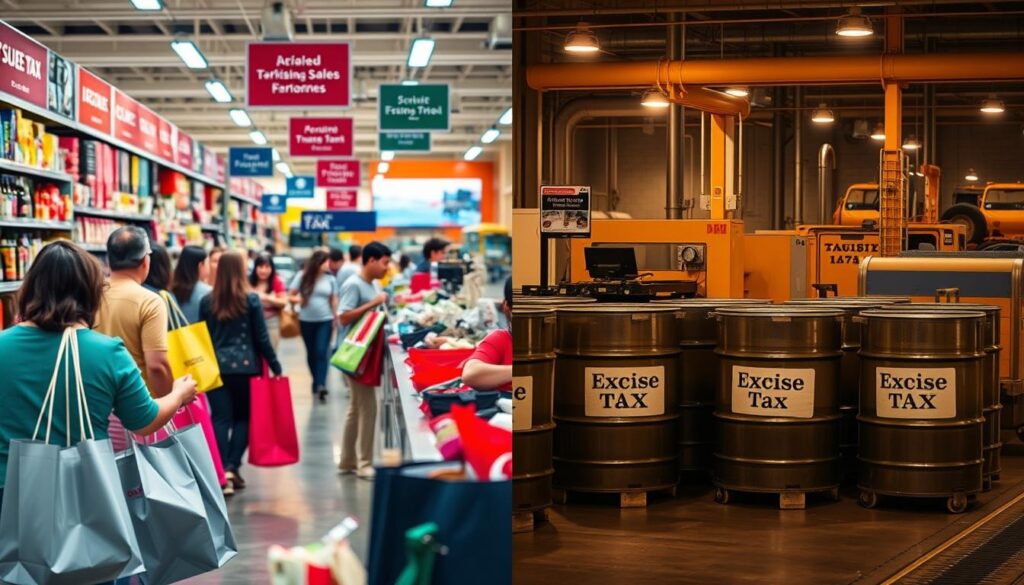
Understanding these differences helps you handle your tax duties better. It lets you see how taxes affect what you buy.
Comparative Analysis: Excise Tax vs. Sales Tax
Let’s explore how excise and sales taxes affect money coming into governments and people’s buying choices. Excise and sales taxes differently shape the economy. They impact government funds and how we decide to spend our money.
Revenue Generation for Governments
Sales taxes and excise taxes both fill government coffers. Sales taxes make up about one-third of state tax income. This is only second to the money that comes from taxes on individuals’ earnings. In some places, like Texas, sales taxes bring in nearly 68% of the state’s money. Other states, like Vermont, get less than 16% from it6. Excise taxes, though, target specific items such as fuel and cigarettes. They add up to 12% of what governments in the OECD area get7. For instance, in 2004, the U.S. got $72 billion from excise taxes, which was only 4% of its total tax money7.
Impact on Consumer Behavior
Excise taxes really impact what people decide to buy. They make folks think twice about buying things like cigarettes and alcohol. When the cigarette tax goes up, there’s a brief jump in money collected. But then, as the higher prices kick in, people buy less6. Sales taxes have a subtler effect. People might choose cheaper items to pay less tax6. Sales taxes are usually shown at the bottom of store receipts. This makes it clear how much tax you’re paying, influencing what you buy.
Regressivity of Taxes
Regressive taxes hit low-income families harder. These families end up spending more of their income on taxed items. Excise taxes are seen as regressive because poor households feel the weight of these taxes more. They spend a bigger share of their money on things that are taxed7. Sales taxes on daily needs, like food and clothes, press further on low-income families. This makes regressive taxes tough for those struggling to make ends meet.
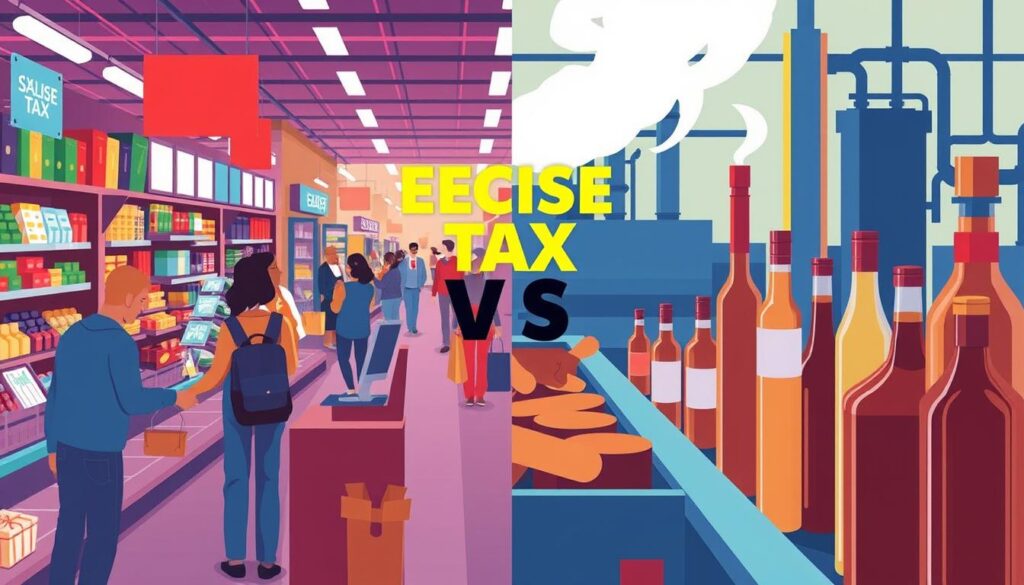
States’ Individual Approaches to Taxation
It’s important to understand how states differ in taxing. Each state has its unique way of applying local sales tax and federal excise tax. This leads to a wide variety of tax systems throughout the U.S.
Variability Across States
Tax rates and rules change from one state to another. For example, five states, including Delaware, Montana, New Hampshire, Alaska, and Oregon8, do not have a general state sales tax. Meanwhile, 38 states allow local taxes on top of state taxes8.
In places like California, sales tax can vary from 7.75% to 10.25%. This shows the big differences in tax rates within the country8.
Local Sales Tax vs. Federal Excise Tax
Understanding local sales tax and federal excise tax is key to knowing your total tax bill. Local and state taxes differ a lot, while the federal government charges the same excise taxes for certain items like alcohol and fuel across the country. So, it’s crucial for businesses and people to know their specific tax obligations.
Examples of Different Tax Structures
States vary greatly in how they tax. For example, Michigan requires businesses to collect taxes if they have employees there. Washington state has similar laws even for those with minor connections, like owning property8. Economic activity also affects taxes, especially after the Supreme Court’s decision in South Dakota v. Wayfair. This ruling means states can charge taxes based on sales within their borders, not just physical presence8.
In 2021, states like Nevada, Washington, South Dakota, and Tennessee got over 20% of their revenue from sales taxes. This shows how different states rely on various taxes9.
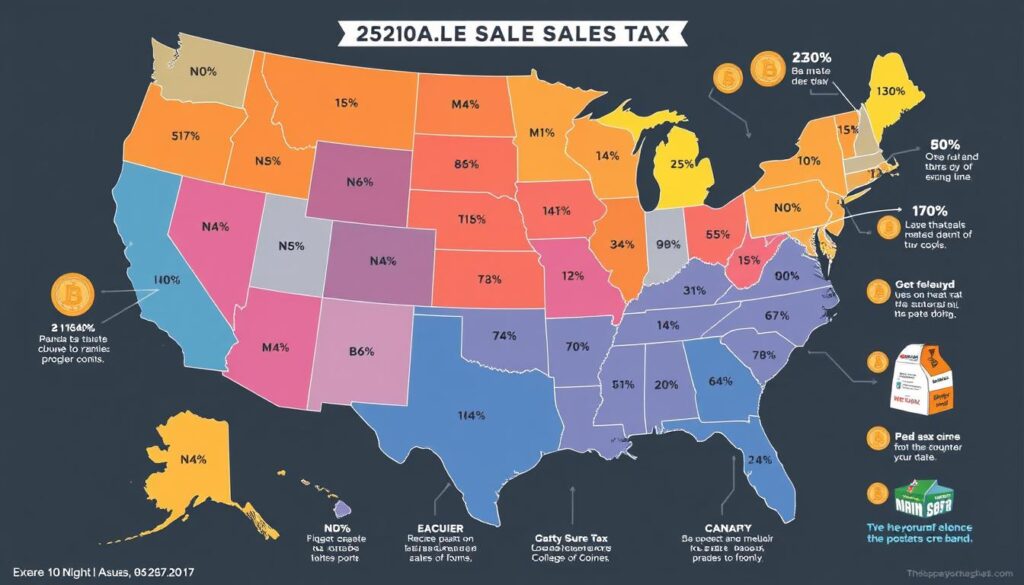
Conclusion
It’s vital to understand how excise and sales taxes differ. These taxes affect how you spend and plan financially. Excise taxes are added to certain items like cigarettes and gas. They’re hidden in the price. Sales taxes, however, show up as extra costs at checkout. They mainly help to pay for things state and local governments need.
This difference is key because it impacts your money. Excise taxes hit specific goods, often used to raise money for special reasons. Sales taxes are more straightforward, showing clearly on your receipt.
Furthermore, sales taxes tend to hit low-income families harder. They spend more of their earnings on things that get taxed this way. This shows sales taxes can be unfair to them10. Meanwhile, excise taxes focus on products viewed as harmful or luxurious. Since these taxes are included in the item’s price, people might not notice them as much. Knowing about these taxes is especially important for business owners. It helps them set prices right and follow tax rules to avoid fines.
In the end, understanding these taxes shows how they affect us and the economy in different ways. By knowing how each tax works and what they apply to, you can make choices that are better for your finances.
FAQ
What is the difference between excise tax and sales tax?
How are excise taxes calculated?
What types of products are typically subject to excise tax?
Who collects excise tax and how?
Are there exemptions for items subject to sales tax?
Why are both excise and sales taxes considered regressive?
How do state excise tax rates differ?
Can sales tax vary within a state?
What is the main purpose of excise tax?
Source Links
- Understanding the Difference Between Excise Tax and Sales Tax – https://www.savantlabs.io/blog/difference-between-excise-and-sales-tax-explained
- What is Excise Tax and How Does it Differ from Sales Tax? – https://www.accuratetax.com/blog/what-is-excise-tax/
- How is an excise tax different from a sales tax – https://tfx.tax/articles/tax-tips/how-is-excise-tax-different-from-sales-tax
- PDF – https://archive.legmt.gov/content/Committees/Interim/2019-2020/Revenue/Meetings/July-2020/HJ-35/ITEP-How-Sales-and-Excise-Taxes-Work.pdf
- Excise Tax: What It Is and How It Works, With Examples – https://www.investopedia.com/terms/e/excisetax.asp
- PDF – https://files.taxfoundation.org/20220112140935/TaxEDU-Case-Study-3-Sales-Taxes-vs-Excise-Taxes.pdf
- Microsoft Word – WP2007-2.doc – https://www.bus.umich.edu/otpr/wp2007-2.pdf
- What is sales tax? – https://tax.thomsonreuters.com/blog/what-is-sales-tax/
- How do state and local general sales and gross receipts taxes work? – https://taxpolicycenter.org/briefing-book/how-do-state-and-local-general-sales-and-gross-receipts-taxes-work
- PDF – https://progov21.org/Download/Document/2Z3X69
